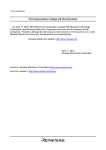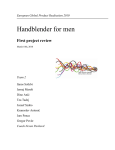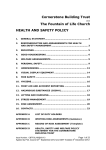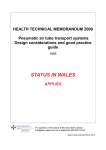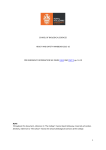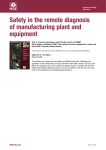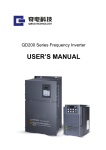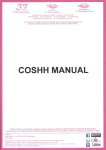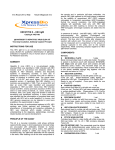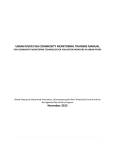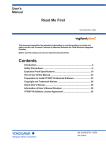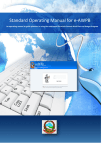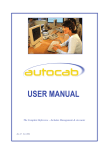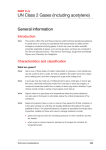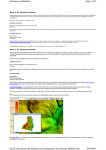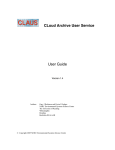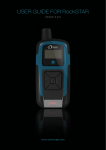Download Guide to Health & Safety Risk Assessment
Transcript
Guide to Health & Safety Risk Assessment The University of Reading Safety Guide 4 (2004 Revision) −−−−−−−−−−−−−−−−−−−−−−−−−−−−−−−−−−−−−−−−−−−−−−−−−−−−−−−−−−−−−−−−−−−−−−−−−−−−−−−−−−−−−−−−−−−−−−− GUIDE TO HEALTH & SAFETY RISK ASSESSMENT Contents Section Page A Introduction 1 B Who should be doing risk assessments? 2 C Specific guidance, risk assessment requirements & training 4 D Fire risk assessment requirements 4 E Research projects and postgraduate students 5 F How to get started with your risk assessments 6 G Recording risk assessments 7 H The risk assessment process: step by step approach 8 STEP 1: Choose an area, activity, project etc. to concentrate on. 8 STEP 2: Identify the significant hazards associated with these. 9 STEP 3: Identify relevant standards. 9 STEP 4: Decide who is at risk and might be harmed. 9 STEP 5: Consider how people might be harmed from these hazards. 9 STEP 6: List the risk controls currently in place to reduce the risks identified. 10 STEP 7: Assessing the level of remaining (or residual) risk. 10 STEPS 8 & 9: Deciding what further action is required - now and in the future 12 STEP 10: Reviewing risk assessments 13 I Informing others of risk assessment findings 14 J Monitoring health and safety performance 14 K Further information & guidance 15 Appendix 1 - Area Health and Safety Risk Assessment Form (RA1) Appendix 2 - Project / Activity Risk Assessment Form (RA2) Appendix 3 - Register of Risk Assessments Completed Appendix 4 - Hazard Checklist Appendix 5 - Specific risk assessment requirements, forms & training Appendix 6 - Example of generic office risk assessment (Form RA1) Appendix 7 - Example of specific risk assessment for DSE work (form RA2) 16 17 20 21 22 23 29 Helen Toll Head of Health & Safety Services University of Reading May 2004 Safety Guide 4 Guide to Health & Safety Risk Assessment − University of Reading _________________________________________________________________________________________________ GUIDE TO HEALTH & SAFETY RISK ASSESSMENT A. INTRODUCTION The Management of Health and Safety at Work Regulations 1992 (revised in 1999), require employers to make a suitable and sufficient assessment of the health and safety risks to employees and non-employees, arising from their work activities. Risk assessment is now a common requirement of all health and safety legislation, the emphasis is now on preventing accidents and work-related ill health, rather than just reacting to incidents, and making improvements after the event. So, what are we trying to prevent? • • • • • • Accidents causing injury or death Near misses (because they could well cause injury if they happen again) Work-related ill health Repetitive / accumulated strain injuries Damage to equipment and the environment Stress related ill health / mental health problems This guide explains how Schools and Directorates should allocate responsibilities for carrying out risk assessments. A step-by-step guide to the process of conducting assessments is provided and a hazard checklist is included to help you get started. Risk assessment forms are also provided, which should be used to record assessments. Examples of assessments are also included as appendices. What do we mean by ‘suitable and sufficient’ risk assessment? By law employers have to carry out risk assessments that are ‘suitable and sufficient’, this means that assessments should: • Be comprehensive and cover the hazards and significant risk of all work activities, including routine and non-routine work, one off as well as regular activities, research work as well as teaching classes, low risk and high risk work, off campus activity as well as activities taking place on our premises; • Be systematic in the way in which hazards are identified, risks are assessed and controls are implemented; • Include risks to health as well as safety, and include risks to mental health; • Take account of risks to non-employees, which in our case includes students, visitors, contractors and guests at events; • Identify groups of people who may be particularly at risk, such as young or inexperienced persons, expectant mothers, visitors unfamiliar with the premises, and people with disabilities or health conditions. • Be undertaken before new workplaces are built i.e. at the design stage (not as an after−thought when making modifications can be more difficult and very expensive. • Ensure the findings of assessments are brought to the attention, in a meaningful and comprehensible way, of those exposed to the risks. ______________________________________________________________________________________ _ (SG4) May 2004 1 Guide to Health & Safety Risk Assessment − University of Reading _________________________________________________________________________________________________ What is the difference between ‘hazard’ and ‘risk’? A hazard is something that has the potential to cause harm, i.e. an activity such as lifting and carrying, using machinery, moving vehicles, using chemicals etc. The risk is the likelihood that harm will result from the activity. For example, asbestos is a hazard, but the level of risk it poses will depend on its type and condition, where it is located and whether it is likely to be disturbed in the future. Appendix 4 contains a checklist of the common workplace health and safety hazards you may encounter. How far should we go in reducing risk? - ‘so far as is reasonably practicable’ Most health and safety legislation requires employers to reduce risk ‘so far as is reasonably practicable’. This means that we must aim to strike a balance between the level of risk on one hand, and the physical difficulty, time, effort and expense, which would be involved in taking steps to reduce or avoid the risk, on the other hand. Therefore higher risks justify greater effort to control and reduce them. In a court of law, it would be up the University to prove that it was not reasonably practicable to do more. The risk assessment process outlined in this Guide should help provide the justification for choosing certain risk controls (and not choosing others). B. WHO SHOULD BE DOING RISK ASSESSMENTS? Heads of School / Directorates are responsible for ensuring that suitable and sufficient assessments of the work activities of their areas are undertaken. They are also responsible for ensuring that risks are adequately controlled and assessments are reviewed on a regular basis. Heads must provide staff with adequate support, time and resources to undertake assessments and ensure that assessors are competent. In practice, the task of actually carrying out risk assessments is usually delegated to those people who are most familiar with the activity, project or equipment being assessed or who create the risk. These individuals, who must attend relevant training, may be local managers, academic supervisors or individuals directly involved in the work; they will understand the nature of the work and are best placed to ensure that on a day-to-day basis, risks are adequately controlled. There should also be consultation with union safety representatives, where these are located in the areas concerned. Heads of School / Directorates should identify in their Area Safety Code or local Health and Safety Policy, which individuals or groups of individuals are responsible for carrying out risk assessments and keeping them up to date. The Head should also arrange for a Register of Risk Assessments (see Appendix 3) to be maintained locally and a copy forwarded to Health & Safety Services and the University Health and Safety Committee, when required (see Section F for more details). There is no prescribed way of allocating these responsibilities, as this will vary from area to area according to structure and activities and should be determined locally by the Head of School / Directorate. However to assist in this process, Table 1 (over page), may be used as a guide. Heads of School / Directorates may appoint one or more persons to specialise in certain types of risk assessment (for example, display screen work, manual handling or work with hazardous substances under COSHH). Specific training courses are available from Health & Safety Services for these risk assessments – see Section C for more information. ______________________________________________________________________________________ _ (SG4) May 2004 2 Guide to Health & Safety Risk Assessment − University of Reading _________________________________________________________________________________________________ Table 1: Guide to allocating risk assessment responsibilities Area or type of work Person allocated responsibility for carrying out risk assessments (they may delegate the actual task) Teaching laboratories Specified academic in charge of laboratory Research laboratories Research supervisor or principal investigator Work with sources of radiation Research supervisor or principal investigator – overseen by School Radiation Protection Supervisor Work with lasers Research supervisor or principal investigator – overseen by School Laser Supervisor Central teaching areas (e.g. seminar / lecture theatres) Support Services Manager, Facilities Management Directorate Administrative areas Senior Administrative Officer / supervisor Individual offices Workshops Each occupier. Alternatively, a person nominated to coordinate these (e.g. Area Health & Safety Co-ordinator) Workshop supervisor Store Rooms Supervisor in charge Common areas within departments (e.g. meeting rooms, corridors with departmental access only) Senior Administrative Officer or Area Health & Safety Coordinator Building fire safety Area Health & Safety Co-ordinator or Building Superintendent University Fire Safety Adviser Student activities off site (e.g. organised visits and field work) Academic in charge (fieldwork Supervisor) Activities of students on placements Academic in charge (Placement Organiser) must assess the suitability (including health and safety) of the placement and ensure a risk assessment of the work of the student, is undertaken by the organisation providing the placement. Catering facilities Manager or Hall Caterer Halls of Residence Hall Manager or deputy Other work within Directorates Area manager or assistant Social Events Event Organiser in consultation with Event Safety Controller Open days, school visit etc. Event organiser Work with Genetically Modified Organisms GM Project Supervisor Monitoring of risk assessments Area Health and Safety Committee members during regular inspections or Area Safety Co-ordinator The role of Area Health & Safety Co-ordinators Area Health & Safety Co-ordinators are not responsible for risk assessments by virtue of being an Area Health & Safety Co-ordinator. They may of course be allocated such responsibility for the area in which they work. They should be able to provide information and advice, and will usually be involved in checking workplaces to see if suitable and sufficient risk assessments are in place. ______________________________________________________________________________________ _ (SG4) May 2004 3 Guide to Health & Safety Risk Assessment − University of Reading _________________________________________________________________________________________________ They may be asked, on behalf of their Head of School or Director, to co-ordinate the risk assessment process, maintain the Risk Assessment Register, and make the latter available for monitoring purposes. C. SPECIFIC GUIDANCE, RISK ASSESSMENT REQUIREMENTS & TRAINING In additional to the general requirement for risk assessments, as required under the Management of Health and Safety at Work Regulations, there are other specific sets of Regulations which require risk assessment of particular hazards - indeed a requirement for risk assessment is now a common theme of all new health and safety regulations. University health and safety guidance has been produced for many of the hazards and legal requirements that relate to the work of the University, and other guidance is continually being developed. Before embarking on your risk assessments, you should check what University guidelines exist, so you are familiar with the legal requirements and standards, relating to the hazard in question. A complete list of University health and safety guidance can be found on the Health & Safety Services website (see Section J: Further Information & Guidance, for details) or copies can be from the Health & Safety Services Office. The hazards relevant to the University are listed in the Hazard Checklist in Appendix 4. For most hazards you can simply follow the step-by-step risk assessment procedure outlined in this guide and use one of the risk assessment forms provided in Appendix 1 or 2. However, there are some hazards which require a more detailed or specialised assessment to comply with legal requirements, or for which, to make the assessment process easier, Health & Safety Services have designed specific assessment forms and checklist. Those hazards for which a specific assessment form should be used, rather than the general forms contained in this Guide, are listed in Appendix 5. All assessment forms are available via the Health and Safety website. Where specific risk assessment training courses are provided, this is indicated also. Health & Safety Services provide an annual programme of training, which includes courses providing guidance on how to carry out both general risk assessments and specific assessments for particular types of activities or hazards. A full list of courses available can be found in the current edition of the Health & Safety Training Prospectus, available from Health & Safety Services or on the Health and Safety website. D. FIRE RISK ASSESSMENT REQUIREMENTS The Fire Precautions (Workplace) Regulations 1997 (amended 1999)) require employers to conduct risk assessments for fire safety as well as for general health and safety hazards. These Regulations place duties on employers and persons in control of premises to comply with requirements relating to: • means of detection and giving warning in case of fire; • the provision of means of escape; • means of fighting fire; • the training of staff in fire safety; • the maintenance of building fire safety hardware (alarms, fire doors, etc). ______________________________________________________________________________________ _ (SG4) May 2004 4 Guide to Health & Safety Risk Assessment − University of Reading _________________________________________________________________________________________________ Compliance with these Regulations depends on two related aspects of fire safety: • structural fire safety - compartmentalisation, means for fire fighting and detection, the provision of emergency routes and exits, disaster plans for high risk buildings, etc; and • use of buildings by occupying department(s) – prevention of fire, safe storage and use of flammable substances, minimising combustible materials, maintenance of unobstructed means of escape, provision of fire routine notices, definition of assembly points, conducting fire drills, keeping training records, co-ordinating maintenance work, managing the presence of disabled persons in the area, etc. In order to assess structural fire safety risks, the University Fire Safety Adviser undertakes detailed fire risk assessments of buildings and advises Estates Services and design consultants on the fire precautions and standards required. The improvements needed are prioritised and, dependent of the level of risk, available finance, future building plans etc, progressive improvements are planned and implemented. Assessing risks associated with the day-to-day use of the building, is the responsibility of Heads of Schools and Directorates, and is usually delegated to local managers responsible for each work area. In addition, to encourage the process of on-going fire safety assessment and inspection, Fire Safety Risk Assessment Checklists are sent each term from the Health & Safety Office to Area Health & Safety Co-ordinators to complete. This process is separate from the general risk assessment procedure covered by this Guidance. However, fire safety risks should always form part of your general risk assessments, when applicable. E: RESEARCH PROJECTS AND POSTGRADUATE STUDENTS Research work is not and never has been exempt from health and safety legislation. However, it is recognised that as the research environment may give rise to unknown or new risks, while the need for researchers to characterise aspects of a process, may bring them into closer contact with hazards. Therefore it is perhaps more difficult to risk assess research work than routine work activities, nevertheless, the basic principles, as outlined in this guide, must still be applied and risk assessments must be carried out for all research projects. This process should commence at the earliest opportunity to maximise the potential for designing hazards out of the research activity. In practice these risk assessments will be undertaken by the Supervisor or research students/assistants under the direction of the Supervisor. Once the risk assessment has been carried out, the necessary control measures identified should be implemented. Controls might include technical controls such as fume extraction or electrical insulation, working practices such as prohibition of lone working on some projects or the provision of personal protective equipment. Risk assessments and risk control methods must be considered when writing protocols for project work. Research project supervisors are expected to see their research workers / students at appropriate intervals dependant upon the degree of risk associated with the research project being undertaken. ______________________________________________________________________________________ _ (SG4) May 2004 5 Guide to Health & Safety Risk Assessment − University of Reading _________________________________________________________________________________________________ There should be formal arrangements in the Department / School to provide a temporary alternate supervisor to cover for planned or unexpected absences of an individual’s normal project supervisor. From time to time, especially when a project is finished, it will be necessary to review how well the health and safety arrangements for that project have worked. This would also be necessary if there are significant changes during the life of the project. If there are changes to the risk assessment then they should be recorded and written into the project protocol. Some schools use the Student Supervision Form (see Health and Safety website ‘Forms’ page) for undergraduate and postgraduate student projects to assess the supervision needs of students. It should be remembered that this form does not constitute a full risk assessment or COSHH assessment, and you may decide to incorporate the assessment of supervision needs into your health and safety risk assessment, rather than complete two separate forms. You will need to indicate on your risk assessment form, what level of student supervision is required during the project, depending on the level of risk associated with the work. The following categories can be used: Risk category for supervision (choose one): ABCD- F. Work must not be started without direct supervision of a named supervisor Work must not be started without the advice and approval of a named supervisor Work may proceed as workers are adequately trained and competent in the procedures involved Work may proceed because there are no significant risks and no special supervision is required HOW TO GET STARTED WITH YOUR RISK ASSESSMENTS – initial survey of activities and hazards a) You should start by listing all the activities that you are responsible for or that affect the health and safety of your staff or students or others who work in, use, or visit your premises. This should not be a detailed list but broad descriptions of functions. b) List all the locations you are responsible for (these will vary according to the type of work and may include temporary sites such as for social events or fieldwork). c) It is a good idea to take a walk around to check the accuracy of your lists. It is easy to forget activities that happen outside normal office hours or only infrequently. Talk to supervisors and other employees to check the completeness of your list. d) Remember that risk assessments are required for all University work activities, although assessments can be generic (see below) and should therefore include the following: • Work areas and work activities (including those conducted out of hours) • Work equipment and use of machinery (including when new equipment is purchased and installed) • Research projects • Social events (see University Safety Guide No. 33) • Field work (see University Safety Guide No. 32) • Emergency situations which may arise – such as fires, explosions, spillage and accidental contamination. ______________________________________________________________________________________ _ (SG4) May 2004 6 Guide to Health & Safety Risk Assessment − University of Reading _________________________________________________________________________________________________ e) Decide which assessments can be generic in nature and which need to be more specific. Are generic or specific risk assessments needed? It is not necessary to carry out an assessment for each and every work activity or for every worker. If risks are of a similar nature in a number of areas within the department or school, or the work activities of a group of staff are similar, then generic risk assessments can be carried out. For example, generic assessments of general office-based, workshop-based or laboratory-based health and safety risks can be undertaken. However, specific assessments will be needed for activities not covered by these generic assessments, or sometimes for individuals who are particularly at risk, such as staff or students with disabilities or expectant mothers. Similarly a generic assessment can be topic or hazard based. For example, an assessment may look at manual handling activities throughout a section or for a particular group of staff, or the storage of highly flammable liquids, throughout your school. An example of a generic office-based risk assessment is included as Appendix 6; this is based on the Health & Safety Services Office. An example of a specific risk assessment, for Display screen equipment (DSE) work, is included as Appendix 7. f) Divide your list into manageable chunks and decide who is the best person to carry out each risk assessment. You may, for example, decide that a supervisor has a more detailed understanding of a particular function. Each risk assessment should take no more that half a day to complete otherwise it should be further subdivided. g) Do not split the task by asking different people to look at different hazards within the same activity, as the inter-relationship of the hazards and possible control measures is important. h) Prioritise the risk assessments you have decided on and set deadlines for their completion. Try to think forward and decide whom you will need to consult for information and who may be useful to assist you with the assessments. G. RECORDING RISK ASSESSMENTS – ASSESSMENT FORMS It is important that you have a means of easily and logically recording the relevant information from your risk assessment and that the format used meets the requirements of the law. We are legally obliged to record the ‘significant findings’ of each assessment. While the legislation does not prescribe how risk assessments should be recorded, there are specific requirements about what is recorded. You should use one of the forms designed by Health & Safety Services included in this guide. If you wish to use a different form, you should discuss this with staff in Health & Safety Services, who will advise you whether your form is a suitable alternative. Records of risk assessments can be electronic, but they must be easily retrievable for use by managers and auditors and external bodies, when required, such as the Health and Safety Executive or Insurance assessors. Two Risk Assessment Forms have been produced in recognition that some activities are more complex than others and one form seldom suits all situations. The two forms RA1 and RA2 are attached as Appendix 1 and 2 and are also available on the Health & Safety Services website (see page 12 for website address). ______________________________________________________________________________________ _ (SG4) May 2004 7 Guide to Health & Safety Risk Assessment − University of Reading _________________________________________________________________________________________________ (i) Area Risk Assessment Form (RA1) You can use this form for fairly simple assessments where the amount of detail required is limited but the activity or area gives rise to a number of different, but fairly straightforward hazards. For example, the form could be used for generic risk assessments of offices, general laboratories (not for high risk laboratory work), workshops and communal areas. This form enables you to assess a number of hazards using the same form. An example of a generic office-based risk assessment using Form RA1 is included as Appendix 6. This assessment is based on the Health & Safety Services Office. (ii) Project / Activity Risk Assessment Form (RA2) This is a more comprehensive form most suited to more complex or higher risk tasks or projects when you wish to consider an activity or piece of equipment in detail. Each section of the form RA2 corresponds to one of the steps in these guidelines, while RA1 follows the same principles, but requires less information and incorporates a hazard checklist. An example of a specific risk assessment for DSE work is included as Appendix 7 (the Further Action sections 8 and 9 have not been completed). You will see that the generic risk assessment example (Appendix 6) covers briefly a number of office hazards, including display screen equipment (DSE) work, whereas the example in Appendix 7, covers DSE risks in much greater detail. The latter approach would be suitable for offices where DSE work is a significant part of the work or where a detailed investigation of a problem area is called for. (iii) Register of Risk Assessments To keep a record of what activities, projects or work areas have been assessed, when these need to be reviewed, and to facilitate auditing - a Register of Risk Assessments (see Appendix 3) should be completed for each School, Hall and Directorate, and a copy should be retained by the Area Health & Safety Co-ordinator. A copy of the Register should also be sent to the Head of School / Directorate and to Health & Safety Services. You do not need to send copies of individual risk assessments to Health & Safety Services, but we are happy to give feed back on any you have produced. Records of risk assessments should be kept for at least 3 years. This is so that, in the unfortunate event of a civil claim being made against the University, we will be in a position to demonstrate, retrospectively, that risks were properly assessed. Note that specific legislation may require the records to be kept for much longer, for example genetic modification risk assessments must be kept for at least 10 years after the activity has ceased. H. THE RISK ASSESSMENT PROCESS: STEP BY STEP APPROACH Once you have carried out your initial hazard survey and decided on what needs to be assessed, who is going to do it, how you will record assessments, and you have ensured that the people involved in the process have received sufficient instruction and training in risk assessment, then you are ready to begin. The various practical steps required to conduct a risk assessment are described in the following text. Each step corresponds to a section of Risk Assessment Form RA2. ______________________________________________________________________________________ _ (SG4) May 2004 8 Guide to Health & Safety Risk Assessment − University of Reading _________________________________________________________________________________________________ STEP 1: Choose an area, activity, project, or piece of equipment to concentrate on. You will have already decided what risk can be covered by generic assessment and where specific assessments will be needed instead. STEP 2: Identify the significant hazards associated with these. You can use the Hazard Checklist included in this guide (Appendix 4), or the list provided in Risk Assessment Form RA1, to help you identify all the relevant hazards. STEP 3: Identify relevant standards. Find out if there are any health and safety policies, best practice guidance, standards or minimum requirements relevant to the activity or hazard you are considering. Managers are expected to know about the hazards in their workplaces, and the main legal requirements relating to their work (even if only in outline). If you do not know you must find out. In form RA2 you are provided with space to record this, but not in form RA1. Relevant sources of health and safety information include: • University health and safety policies or guidance − check the University Health & Safety website or talk to your Area Health & Safety Co-ordinator (see also Appendix 5) • Legislation and supporting Approved Codes of Practice which give practical guidance and include basic minimum requirements (produced by the Health & Safety Commission). • Guidance published by the Health and Safety Executive (HSE) – see their website www.hse.gov.uk • Relevant British and European Standards • Product information from suppliers and manufacturers • Industry, trade association or trade union health and safety guidance • Do not forget to consult those actually doing the work, they are often the experts! STEP 4: Decide who is at risk and might be harmed. In addition to staff and students actually involved with the activity, you should also consider risks to cleaners, contractors, maintenance workers and agency workers who may not be in the workplace all of the time and may not be familiar with the risks. Also do not forget visitors (including children) or other organisations you share your workplace with, if there is a chance they could be harmed by your activities. Also consider workers who might be at particular risk like young workers, trainees, new and expectant mothers or people with reduced mobility or disabilities. STEP 5: Consider how people might be harmed from these hazards. Consider what kind of injury or ill−health people might suffer if exposed to the hazards and how severe the outcome is likely to be. In form RA2 you are provided with space to record this, but not in the simplified form RA1. You can use Table 2 on the next page to help you categorise risk according to the severity of the outcome. Try to avoid always choosing the worst case scenario. For example, if someone tripped on a trailing cable, they could, in theory fall and bang their head, experience a blood clot and end up dying, so you might be tempted to record the severity (Table 2) as ‘fatal’. Indeed you may conclude that any injury could in theory be fatal. Taking this approach ______________________________________________________________________________________ _ (SG4) May 2004 9 Guide to Health & Safety Risk Assessment − University of Reading _________________________________________________________________________________________________ will skew your risk assessments, and it will be very difficult to prioritise any action needed, if everything ends up as a ‘high risk’. Instead, a more realistic approach is needed. Most slips and trips lead to minor injuries, but sprains and strains leading to time off work are not uncommon, so you should choose a severity of either ‘minor’ or ‘serious’, depending on the work environment. STEP 6: List what risk controls are currently in place to reduce the risks identified. In other words what steps do you currently take to protect the health and safety of the groups of people identified, from the hazards under consideration? Risk controls might be: (i) Physical - such as machine guards, enclosures, interlocks, restricted access or local exhaust ventilation; (ii) Administrative - such as established safe working procedures, emergency procedures, information, supervision and training, or (iii) Personal protective equipment - which is provided and worn. Remember to include any relevant preventive maintenance programmes and regular inspections, such as those carried out by insurance company engineers, as these too are risk control measures. You also should consider if these risk controls are adequate, compare them with the relevant legal requirements, standards or guidelines, as identified in Step 3. It is important to find out if the controls put in place are actually used in practice. Also think about what is done to check that these controls are in good working order, is any preventive maintenance or servicing carried out, or any visual checks and inspections? STEP 7: Assessing the level of remaining (or residual) risk. It is essential to now consider whether, given the existing measures that are taken or risk controls that are already in place, what the remaining level of risk actually is. This is where knowing how your current arrangements compare with best practice and legislative requirements is important how else do you know whether you are doing all you should be doing to reduce health and safety risks? On Risk assessment form RA1, you are provided with columns to indicate whether you have assessed the risk as ‘low’, ‘medium’ or ‘high’. Making this kind of judgement can be very subjective and results can vary considerably from one assessor to another. More objective assessments will be produced if the approach taken to evaluating risk considers the factors that contribute to increased risk in a consistent way, these are: (i) The severity of the harm that exposure to the hazard could cause (S) (ii) The probability of exposure to the hazard (P) To help you evaluate the level of risk you can do a very simple calculation to produce a risk score which corresponds to a risk level of low, medium or high. Simply decide the level of severity (S) (Table 2. over page) and a level of probability (P) (Table 3. over page) for the hazard in question and multiply the scores together as described. On risk assessment form RA2 space is provided to record these scores (and the scores are given in brackets for each category selected). For more ______________________________________________________________________________________ _ (SG4) May 2004 10 Guide to Health & Safety Risk Assessment − University of Reading _________________________________________________________________________________________________ simple or generic risk assessments recorded on Risk Assessment form RA1 − you are just invited to select from the categories ‘low’, ‘medium’ or ‘high’, but you can use the scoring system described above, if you wish to take a more objective approach. Table 2: Risk Severity (S) - The severity of any resulting injury or ill−health. Category MINOR Example SERIOUS More serious injuries or ill-health, requiring time off work or study or a hospital visit, e.g. burns, sprains, strains and short-term musculoskeletal disorders, cuts requiring stitches, back injuries, fractures to fingers or toes. More serious property damage. Broken limbs, amputations, long-term health problems resulting from work, or acute illness requiring medical treatment, loss of consciousness, serious electric shock, loss of sight. Major property damage. Injury or ill-health which leads to death either at the time or soon after the incident, or eventually, as in the case of certain occupational diseases, such as asbestos-related cancers. MAJOR FATAL Superficial injuries - cuts, bruises, mild skin irritation, mild aches and pains − requiring first aid only. Minor property damage. Score 1 2 3 4 Table 3. Risk Probability (P) - the likelihood of the hazard causing harm. Category VERY UNLIKELY UNLIKELY POSSIBLE LIKELY Example (for guidance only - some or all may apply for each category) Score Good control measures are in place. Controls do not rely on a person using them (i.e. personal compliance). Controls are very unlikely to break down. People are very rarely in this area or very rarely engage in this activity. Reasonable control measures are in place but they do rely on a person using them (some room for human error). Controls unlikely to breakdown. People are not often in this area / do not often engage in this activity / this situation is unlikely Inadequate controls are in place, or likely to breakdown if not maintained. Controls rely on personal compliance. People are sometimes in this area or sometimes engage in this activity / this situation sometimes arises Poor or no controls in place. Heavy reliance on personal compliance (lots of room for human error). People are often in this area / engage in this activity on a regular basis / this situation often arises. 1 2 3 4 The scores can be represented in a matrix, shown as in Table 4 below. Risk scores correspond to a risk level − high, medium, low etc. Table 4. Risk Score Matrix SEVERITY OF OUTCOME (S) RISK SCORE = SXP P R O B A B Very Unlikely Minor Serious Major Fatal 1 2 3 4 Risk Level Low Medium Unlikely 2 4 6 8 High Very High ______________________________________________________________________________________ _ (SG4) May 2004 11 Guide to Health & Safety Risk Assessment − University of Reading _________________________________________________________________________________________________ I L I T Y (P) Possible 3 6 9 12 Likely 4 8 12 16 What about the number of people at risk? Another risk factor that should be considered when evaluating the level of risk is the actual number of people at risk at any one time (sometimes known as the extent of risk). In general, for risks at a similar level, a higher priority should be given to actions which reduce risks affecting a greater number of people. Why use a quantitative (numerical) system of categorising risks? Expressing risk levels as scores can very useful when making decisions about prioritising action and allocating resources. Scores derived using a common method will enable comparisons to be made between one activity or part of the organisation, and another. STEPS 8 & 9: Deciding what further action is required - now and in the future What if you discover that the existing measures in place for controlling risks are not adequate to protect the health and safety of staff, students or others? This may be either because controls do not meet the required standard, are not working properly, are not being used, or are deteriorating due to lack of maintenance and checking. In this case, you must establish what further action is required to reduce risks, so far as is reasonably practicable (see definition on page 2), and by when this should be achieved. If action can be taken immediately to improve health and safety standards, such as replacing machine guards or clearing obstructed gangways or fire exits, then this should be carried out without delay, and recorded on the risk assessment form. When considering what further control measures you should adopt to reduce or manage health and safety risks, you should follow the Hierarchy of Risk Controls. Priority should be given to collective protective measures, over individual protective measures. Controls such as personal protection should only be a last resort, if there is no other way of reducing risk at source. In practice a combination of these risk controls is often required. ______________________________________________________________________________________ _ (SG4) May 2004 12 Guide to Health & Safety Risk Assessment − University of Reading _________________________________________________________________________________________________ Hierarchy of Risk Controls (Priority should be given to the controls at the top of this list) • Prevent the hazard from arising, so that risk can be avoided (eliminate or avoid the hazard) • • Find a less hazardous alternative (substitute the hazard) Reduce the risk at source to protect all (e.g. improve workplace layout or design or • Introduce administrative controls such as written safe systems of work, information, instruction and training on risk reduction Personal protection e.g. protective clothing (last resort as only individuals are introduce engineering solutions like machine guards or fume / dust extraction) • protected) It may be necessary to clarify the safe systems of work you introduce by issuing them to staff or students as written procedures, guidelines or policies. Remember to ensure people receive adequate training in any new procedures. Action plans – implementing risk controls It is strongly recommended that you draw up a health and safety action plan to ensure that improvements needed are prioritised according to the level or risk identified. Remember to include realistic time scales in your action plan and identify who will be responsible for checking that the objectives of the plan have been met. It is up to you to decide on appropriate time scales for action, but some typical timescales, according to risk are given as a guide in Table 5. Table 5: Scores and Typical Action Plan Time Scales SCORE RISK LEVEL TYPICAL TIME SCALES FOR ACTION REQUIRED 1 Insignificant No further action needed 2−3 Low 4−6 Medium Action within 12 months if improvements are reasonably practicable Action within 6 months based on reasonable practicability 8−9 High 12 − 16 Very high Action within 1 month to reduce risk (immediate action may be needed in some circumstances) Immediate action required – work should stop / not commence until risk has been reduced to acceptable levels STEP 10: Reviewing risk assessments Risk assessments should be reviewed regularly and modified if necessary. They should not be a once-and-for-all activity, but equally, they do not have to be re-written every year. As the nature of work changes and our appreciation of hazards and risks develops over time, so risk assessments should evolve accordingly. Assessments should be reviewed: ______________________________________________________________________________________ _ (SG4) May 2004 13 Guide to Health & Safety Risk Assessment − University of Reading _________________________________________________________________________________________________ • If significant changes are made to existing workplaces, work activities, projects or equipment, such that the original assessments are no longer valid; • If new or temporary members of staff are employed who may be more at risk due to inexperience, age or physical or mental health conditions and disabilities; • If female staff announce that they are pregnant, and their work could give rise to a health risk to the mother or unborn child; • If new legislation / guidance / codes of practice or national standards are introduced; • Following accidents or near misses which highlight deficiencies in existing risk control measures or previously unforeseen hazards; • AND on a regular basis − every 12 months is recommended (although every 2 years would be acceptable for low risk administrative departments). I. INFORMING OTHERS OF RISK ASSESSMENT FINDINGS All employees and students exposed to risks to their health and safety must be informed, as part of their induction, about these risks and the control measures introduced to manage and reduce risk. This is so that people understand the reasons behind the safe working procedures they are expected to follow and the personal protective equipment they have to wear etc. An understanding and acceptance of health and safety procedures by staff and students is more likely to ensure their cooperation. The information provided must be meaningful and easy to comprehend. Staff or students can be given copies of individual assessments, and this would be particularly appropriate for hazardous activities, such as work with machinery or for research projects, where a very clear understanding of the risks and control measures employed is essential. Alternatively, the findings of assessments can be incorporated into local written health and safety procedures, Area Health & Safety Codes or Policies, Health and Safety Manuals etc. as appropriate. It is a good idea to get individuals to sign a record to confirm they have received and understood the information provided to them. ‘Health and safety risk assessment’ should be a standing item for discussion at staff meetings and Area Health and Safety Committees meetings. J. MONITORING HEALTH AND SAFETY PERFORMANCE It is important to ensure that once risk control measures are introduced; there is a system in place to regularly check that risks are still being adequately managed in the workplace on a day-to day basis, and that standards are not left to deteriorate over time. It is therefore essential that health and safety performance is monitored by the Head of School / Directorate. One form of proactive monitoring, which is required by the University, is for each area to undertake regular workplace health and safety inspections. The frequency of such ______________________________________________________________________________________ _ (SG4) May 2004 14 Guide to Health & Safety Risk Assessment − University of Reading _________________________________________________________________________________________________ inspections depends on the risk, but an inspection at least every 6 months is recommended in low risk office-based environments, while every term would be a more appropriate frequency for higher risk environments like laboratories and workshops. Ideally, these inspections should be undertaken using an inspection checklist. As workplace inspections should provide a check that the controls listed in your risk assessments are still in place, still effective and still relevant - the findings of your risk assessment (i.e. the ‘controls’ listed) should be used to develop your inspection checklist. For example, if one of your risk controls is the regular inspection of portable electrical appliances, this should be listed as an item to check during your workplace inspection. In addition to proactive monitoring, reactive monitoring of health and safety performance, in the form of reporting and investigation of accidents and incidents, including ‘near misses’, should also be undertaken within each school or directorate. The results of investigations may point to inadequate initial assessment of risk, or poorly managed or absent risk controls. This should prompt a review of the relevant risk assessment. Further guidance on health and safety inspection and health and safety performance monitoring in general is available from Health & Safety Services. K. FURTHER INFORMATION & GUIDANCE 1. Further advice and guidance is available from Health & Safety Services staff or from the Health & Safety Services website which contains University health and safety guidance and policies, risk assessment forms and examples of risk assessments. Health & Safety Services Facilities Management Directorate, Room 110 Physics Building, Whiteknights Tel: 0118 931 8888 Email: [email protected] Website : www.extra.reading.ac.uk/safety/ 2. Risk assessment training courses are provided by Health & Safety Services – see the Health and Safety website or current edition of the Health and Safety Training Prospectus for details (the prospectus is issued annually to Area Health & Safety Co-ordinators). 3. The Health and Safety Executive (HSE) website www.hse.gov.uk. contains a lot of useful general and topic-specific health and safety guidance, much of which can be downloaded free. HSE priced publications are available from HSE Books (Tel: 01787 881165 or visit www.hsebooks.com), or from bookshops such as Waterstones on campus. Health & Safety Services also keep a library of reference material which can be borrowed. A selection of health and safety videos is also available. 4. Management of Health and Safety at Work. Management of Health and Safety at Work Regulations 1999. Approved Code of Practice. HSE Books L21. ISBN 07176 0412 8 (£5.00). ______________________________________________________________________________________ _ (SG4) May 2004 15 AREA HEALTH AND SAFETY RISK ASSESSMENT FORM (RA1) Assessment Reference No. Area or activity assessed: Assessment date Persons who may be affected by the activity (i.e. are at risk) SECTION 1 : Identify Hazards - Consider the activity or work area and identify if any of the hazards listed below are significant (tick the boxes that apply). 1. Fall of person (from work at height) 6. 2. Fall of objects 7. 3. 4. 5. Slips, Trips & Housekeeping Manual handling operations Display screen equipment 8. Lighting levels Heating & ventilation Layout , storage, space, obstructions 11. 12. Use of portable tools / equipment Fixed machinery or lifting equipment 16. 17. 13. Pressure vessels 18. Vehicles / driving at work Outdoor work / extreme weather Fieldtrips / field work 21. 22. 23. 9. Welfare facilities 14. Noise or Vibration 19. Radiation sources 24. 10. Electrical Equipment 15. Fire hazards & flammable material 20. Work with lasers 25. Hazardous fumes, chemicals, dust Hazardous biological agent Confined space / asphyxiation risk Condition of Buildings & glazing Food preparation 26. Occupational stress 27. Violence to staff / verbal assault 28. Work with animals 29. 30. Lone working / work out of hours Other(s) - specify No. Name of Assessor(s) Review date High SIGNED Med Low (provide timescales and initials of person responsible) Number of continuation sheets used: APPENDIX 1 SECTION 2: Risk Controls - For each hazard identified in Section 1, complete Section 2. For more complex activities or projects you are advised to use Form RA2. Hazard Hazard Description Risk Level (tick one) Existing controls to reduce risk Further action needed to reduce risks 16 AREA HEALTH AND SAFETY RISK ASSESSMENT FORM (RA1) Health and Safety Risk Assessments – continuation sheet Assessment Reference No SECTION 2 continued: Risk Controls Continuation sheet number: Hazard No. Hazard Description Existing controls to reduce risk Risk Level (tick one) Further action needed to reduce risks High (provide timescales and initials of person responsible) Med Low APPENDIX 1 Name of Assessor(s) Review date SIGNED Number of continuation sheets used: 17 APPENDIX 2 PROJECT/ACTIVITY RISK ASSESSMENT FORM (RA2) Ref. No. School / Dept / Unit A: Identifying workplace hazards and existing controls 1. Brief summary of work activity or project assessed 2. List significant hazards (refer to Hazard checklist in SG4 Guide to H&S Risk Assessment) 3. Relevant University or local guidelines or standards 4. List who might be exposed to the hazards (e.g. staff, students, visitors, consider numbers at risk) 5. How might they be harmed? (type of injury or health problem that might result) 6. List control measures in place to reduce risks Assess whether these controls are adequate, actually used in practice and regularly checked, where appropriate. (SG4) May 2004 18 APPENDIX 2 B: Assessing the level of risk and further action needed 7.1 How severe is any injury or health effect likely to be? 7.2. How likely is exposure to the hazard? 7.3. Calculate the risk score by multiplying the 2 scores in Q7.1 & 7.2 Tick one box Minor (1) Serious (2) Major (3) Fatal (4) (P =score given in brackets) Very unlikely (1) Unlikely (2) Possible (3) Likely (4) Risk Score (S x P) = Low Medium High Very High (S =score given in brackets) Tick one box (1−3) (4−6) (8−9) (12−16) 8. Immediate action to be taken to make the situation safe / reduce risk to health Action to be Target Date taken by whom? 9. Further action or additional controls needed to reduce risk as low as reasonably practicable Action to be Target Date taken by whom? Name of Assessor (please print) Signature of Assessor Date: Signature of Head of Department / Section 10. Date for Review (maximum 12 months from date of assessment) Date: (SG4) May 2004 Date: 19 APPENDIX 3 REGISTER OF RISK ASSESSMENTS COMPLETED SCHOOL / DIRECTORATE Ref. no. SECTION / DEPARTMENT Work activity / hazard assessed SIGNED: Head of School / Directorate NAME: (please print) Date of assessment Risk Level Low/Med/High/ V.High or Risk Score Review date DATE: A copy of this Register should be maintained by the Head of School / Directorate and the Area Health & Safety Co-ordinator. A copy should also be sent to Health & Safety Services. (SG4) May 2004 20 HAZARD CHECKLIST APPENDIX 4 CATEGORY EXAMPLES OF TYPE OF HARM Tripping and slipping Work at heights Obstructions Stacking/Storage (excludes property damage) Injury Fall of persons or objects Striking against, tripping over, blocking emergency escape routes Falling materials, back injuries, falls during retrieval Temperature Ventilation & humidity Manual Handling Work with Display screen equipment (DSE) Repetitive movements Fire and explosion Hazardous chemicals substances Use, storage & disposal* Biological agents* Genetically Modified Organisms Flammable substances* Cryogenic liquids* Occupational stress Attack by people or verbal assault Work with animals Mechanical (machinery) Vehicles & driving Electrical Large crowds Handling food Contractors Work out-of-hours / lone working Work outdoors Field trips and field work Work in public areas Confined spaces Work over or near liquids, grain, etc Pressure & stored energy Thermal Noise Vibration Ionising radiation Non ionising radiation Lasers Light (Also poor lighting can increase risk of contact with other hazards) Heat stress, sunburn, melanoma, hypothermia ‘Sick Building Syndrome’, nausea, tiredness, dry or itchy eyes Back injury, musculoskeletal disorders, hernia, other injuries Musculoskeletal disorders, eyestrain or soreness, headaches and blurred vision, fatigue, occupational stress Musculoskeletal disorders Burns, health effects of smoke inhalation, exposure to hazardous substances and toxic fumes, psychological trauma Acute and chronic health effects, allergies (sensitisation) Human and zoonotic diseases (infections passed via animals to humans), allergies (sensitisation), blood-borne viruses Fire explosion, thermal runaway Frostbite, asphyxiation Anxiety, depression or other mental health problems. Stress- related physical symptoms, behaviour or illnesses Injury, anxiety and stress, post traumatic stress disorder Injuries - bite, sting, crushing, kicking etc. Ill health effects – zoonotic diseases, allergies Trapping by, impact or contact with moving parts (cutting, friction or abrasion), entanglement in rotating parts, injury from ejection Road traffic accidents – injuries to driver, passengers or third parties, fatigue, musculoskeletal disorders from poor driving posture. Shock/burn/fire/explosion, ignition source Crushing, persons trapped in the event of emergency, heat exhaustion, fire Food poisoning, cross contamination Injuries and ill health to employees caused by contractor’s work or to contractors’ employees due to work in host premises Various depending on work, including inability to summon help in an emergency, possibly increased vulnerability to assault Sunburn, skin cancer, hypothermia, heat stroke, bites and stings, contact with poisonous plants, tetanus from soil, road traffic accidents Various depending on activity and location – including tropical diseases, risk of terrorist attack and hijacking in some areas Injuries and ill health to public Asphyxiation, explosion, poisoning Fall into substances, drowning poisoning, suffocation, etc. Release of energy – explosion, flying / falling materials Burns/fires/scalds/frostbite Hearing loss, tinnitus, inability to hear fire alarm etc. Hand-Arm Vibration Syndrome, whole body effects Burns, cancer Burns, possibly other health effects (not proven) e.g. mobile phones Beam hazards - burns, tissue damage, eye damage Non- beam hazards e.g. electricity, hazardous substances, fire Eye strain, arc eye and cataracts NB: This list is not designed to be exhaustive; there may be other hazards in your workplace not listed here and other types of harm associated with these hazards. (SG4) May 2004 21 APPENDIX 5 Specific risk assessment requirements, forms & training Hazard or type of work University Guidance Specific Risk Assessment Form available? Training course provided? Work with Display screen equipment Visual display units (SG13) YES - DSE Workstation Assessment Form in SG13 YES Manual handling and lifting In preparation – contact Health & Safety Services YES - Manual Handling Assessment Forms (see website) YES Work with hazardous substances In preparation – contact Health & Safety Services YES - COSHH Assessment Form (see website) YES Work with biological agents Control of biological hazards (SG14) YES - COSHH Assessment Form (see website) Included in COSHH training Personal protective equipment (PPE) Personal protective equipment (SG 27) Separate assessment no longer required – PPE should be considered in general and COSHH assessments Included in COSHH training Fire risk assessment Fire safety (SG34) YES - Fire Risk Assessment checklists issued by Fire Safety Adviser Contact Fire Safety Adviser In preparation Contact Fire Safety Adviser Fire Drills (SG5) Emergency evacuation of people with disabilities In preparation – contact Health & Safety Services Dangerous substances Dangerous Substances and Explosive Atmospheres Regulations, DSEAR. (SG24) NO – include in general or COSHH assessments Contact Fire Safety Adviser New and expectant mothers Health and Safety Guidance Notes on Maternity Issues (SN27) YES - See guidance SN27 Contact Health and Safety Adviser Field work Fieldwork (SG32) Examples available - see guidance SG32 YES Students placements Student placements (SG31) Checklist available – see guidance SG31 YES Social Events Social events (SG33) YES - See guidance SG33 YES Food Safety & Hygiene Food Safety & Hygiene (SG29) YES - See guidance SG29 YES Vibration Health & Safety Guidance Note on Hand Arm Vibration (SN23) NO – use general risk assessments forms Contact Health and Safety Adviser Noise In preparation – contact Health & Safety Services NO – use general risk assessments forms Contact Health and Safety Adviser Ionising and non-ionising Radiation Safety Guides 16 – 22 (radiation, lasers, UV) NO – use general risk assessments forms YES Work with Genetically Modified Organisms Genetic modification work (SG15) YES - See guidance SG15 and H&S website YES (SG4) May 2004 22 EXAMPLE OF GENERIC OFFICE RISK ASSESSMENT (Form RA1) HSS/OFFICE/O4 11 March 2004 Staff, visitors, contractors Assessment Reference No. Assessment date Persons who may be affected by the activity (i.e. are at risk) Area or activity assessed: Health & Safety Services - Offices Physics Building, 1st Floor SECTION 1: Identify Hazards - Consider the activity or work area and identify if any of the hazards listed below are significant (tick the boxes that apply). 1. Fall of person (from work at height) 9 6. 2. Fall of objects 9 7. Slips, Trips & Housekeeping Manual handling operations Display screen equipment 9 8. 9 9 3. 4. 5. Use of portable tools / equipment Fixed machinery or lifting equipment Vehicles / driving at work Outdoor work / extreme weather Fieldtrips / field work 9 19. Radiation sources 9 20. Work with lasers 16. Lighting levels 9 11. Heating & ventilation Layout , storage, space, obstructions 9 12. 9 13. Pressure vessels 18. 9. Welfare facilities 9 14. Noise or Vibration 10. Electrical Equipment 9 15. Fire hazards & flammable material 9 9 17. 21. 22. 23. 24. 25. Hazardous fumes, chemicals, dust Hazardous biological agent Confined space / asphyxiation risk Condition of Buildings & glazing Food preparation 26. 27. 28. 9 29. 30. Occupational stress Violence to staff / verbal assault Work with animals Lone working / work out of hours Other(s) – specify Site visits 9 9 9 9 Hazard No. 5 Hazard Description Existing controls to reduce risk Work with Display Screen Equipment (DSE) • • • Prolonged poor seated posture at DSE workstation Ö musculoskeletal problems. • • Repetitive movements (e.g. use of keyboard and mouse). Eye strain, fatigue • • • Staff who are ‘DSE users’ are identified DSE assessor appointed and trained Workstation assessments carried out for DSE Users, using University checklist in Safety Guide 13 – reviewed annually Free eyesight tests offered to all DSE Users Ergonomic office chairs and desks, foot rests, wrist rests etc. provided Good office organisation and layout to allow sufficient working space around each desk Adequate storage space provided Provision of adequate lighting and window blinds Risk Level (tick one) Further action needed to reduce risks High (provide timescales and initials of person responsible) Med Low • 9 • • • • 23 23 Ensure all Users have been provided with guidelines and training on correct posture and DSE workstation adjustment (DSE Users training course, University DSE leaflet) Encourage staff to take regular breaks/change activities /take a lunch break Encourage staff to report any DSE related health symptoms (and seek advice from Occupational Health where appropriate) Discourage prolonged use of laptop PCs Conduct regular workplace health and safety inspections APPENDIX 6 SECTION 2: Risk Controls - For each hazard identified in Section 1, complete Section 2. For more complex activities or projects you are advised to use Form RA2. Health and Safety Risk Assessments – continuation sheet Assessment Reference No Continuation sheet number: HSS/OFFICE/O4 1 SECTION 2 continued: Risk Controls Hazard No. Hazard Description Falling materials 1, 2 from insecure stacking or storage Fall of persons during storage or retrieval of equipment and materials Spillages, slippery or sloping surfaces Uneven surfaces / changes in floor level Damaged or loose floor surfaces Trailing cables, obstructions such as boxes, bags, files etc. Striking against objects • Adequate amount of storage space /shelving is provided • Safe storage arrangements ensure that objects are stable and easily accessible • Kick stool provided to reach high shelves in stationary room • Filing cabinets – either have safety feature (only one draw can be opened at a time) or warning notice affixed • All floor surfaces are in good condition • Good housekeeping standards • Gangways are free of obstructions/protrusions • Storage along fire escape routes /near fire exits is prohibited • Provision of hangers for bags and coats • Liquid spillages are cleared up promptly • Cabinet doors & drawers are kept shut when not in use • Good office organisation and layout to allow sufficient working space around each desk and provide gangways that are wide enough for ease of movement (e.g. at least 1 metre wide) • Provision of adequate lighting • Guidelines provided to staff to raise awareness (Area H&S Policy) Risk Level (tick one) Further action needed to reduce risks High (provide timescales and initials of person responsible for action) Med Low 9 9 • Encourage staff to use Kick stool, not stand on chairs or boxes • Conduct regular workplace health and safety inspections – check storage arrangements • Minimise unstable storage at high level (store light objects only) • Remove archive storage from Plant Room • Ensure the safe routing of cables -use cable ties / covers to eliminate tripping hazards • All damaged flooring to be reported and repaired promptly • Carry out regular workplace health and safety inspections • See also Further Action recorded under ‘Fire’ • Encourage staff to keep the area around and under their desks clear (‘clear desk’ policy) • Encourage regular clearouts of waste, and archiving of paperwork • Arrange regular ‘Housekeeping days’. First one organised for 2nd April 2004. 24 24 APPENDIX 6 3, 8 Slips, trips & housekeeping hazards Existing controls to reduce risk Health and Safety Risk Assessments – continuation sheet Assessment Reference No Continuation sheet number: HSS/OFFICE/O4 2 SECTION 2 continued: Risk Controls Hazard No. 4 Hazard Description Existing controls to reduce risk • Manual handling leaflet provided to staff re. Musculoskeletal problems from lifting & carrying - e.g. collecting deliveries of HSE leaflets & stationary; carrying training handouts & IT equipment, tea urn & display boards etc. • Possible back injuries, other muscle strains & sprains, hernias, cuts, scalding from hot water. • • • • • safe lifting techniques Two people / team lifting encouraged for heavy/awkward objects Portering Service available for moving large items or for office moves Trolleys and sack trucks available (located in Physics Loading Bay Area). Staff use the lift whenever possible when moving heavy loads. Staff drive to training venue if possible, when they need to carry lots of equipment & handouts Safe storage arrangements (e.g. heavier items stored at waist height to facilitate safe lifting, weight of objects stored at low or high level minimised. Purchase of insulated hot water urn with handle Further action needed to reduce risks High (provide timescales and initials of person responsible for action) Med Low 9 • Encourage staff to seek help when lifting • • • • • • 25 heavy or awkward loads. Minimise carrying distances where possible ( e.g. arrange delivery of supplies to office) Prior to lifting, ensure route is free of obstructions, floor surfaces are in good condition etc. Ensure easy access and manoeuvrability during manual handling Ensure sufficient rest and recovery time is taken during repeated lifting Identify vulnerable staff (e.g. pregnant, those with health problems) – assess capability to lift, prohibit from certain tasks if necessary; seek advice from Occupational Health Service when appropriate. APPENDIX 6 Manual Handling Risk Level (tick one) 6, 7 Lighting, heating & ventilation • Reasonable fluorescent strip lighting provided. 9 Additional angle-poise lamps available also. • Blinds provided at windows. • Can be cold in winter/ too hot in summer, particularly Room 111A. Additional portable heaters provided in all rooms. • Windows can be opened to provide ventilation. 25 Health and Safety Risk Assessments – continuation sheet • Secretary to put on portable heater in room 111a on cold Monday mornings, when she first arrives. • Window in Room 112 is difficult to open, monitor condition. Assessment Reference No Continuation sheet number: HSS/OFFICE/O4 3 SECTION 2 continued: Risk Controls Hazard Description 10 Electrical equipment • Electrical installation meets BS and is Office, kitchen & portable electrical equipment. • • Electric shock or burns from contact with live parts due to damaged cables and casing • Faults or overloading of sockets causing overheating and fire Existing controls to reduce risk • • maintained in a safe condition as per IEE Wiring Regulations. All equipment purchased meets EC standards Sufficient socket outlets are provided in each office. Portable appliance testing is carried out by an approved contractor as per University Guidance Safety Guide no.s 11 & 12 Appliances are appropriately labelled to denote last and next test date (last test October 2003). Staff do not attempt any electrical repairs themselves – only competent and authorised persons to work on electrical systems. Risk Level (tick one) Further action needed to reduce risks High Low (provide timescales and initials of person responsible for action) 9 • Instruct staff not to use equipment which Med has not been tested. • Staff should be encouraged to visually check equipment before use. If they are in any doubt about the safety of equipment, it must not be used and must be reported to Head of Health & Safety Services. • Ensure sockets are not overloaded, include item in regular health and safety inspection. • Ensure cabling is not subjected to damage by furniture (e.g. desk legs, chairs and cabinets) or pedestrians. All cables that must traverse traffic routes should be protected by cable covers if they cannot be safely re-routed or tied back out of the way. 26 APPENDIX 6 Hazard No. 9 Welfare facilities 24 Condition of buildings, glazing • Tea & coffee making facilities provided in room 9 109, but no running water supply. • Adequate toilets & washing facilities nearby. • First aider in the team (KO), First Aid kit kept in room 112, contents maintained by KO. • Further first aiders provided in Physics & IT Services. First Aid Room, Physics Rm • With agreement, staff can use Maths Kitchen at end of corridor for water supply (to fill up 3 litre water container) and for washing cups. • Maintain supplies of disposable cups, to use for visitors. • Put list of other local first aiders on staff notice board. • Good structural condition, no low level glazing • Asbestos survey of building carried out, 9 • Window in Room 112 is difficult to open, monitor condition. • Loose ceiling tile, Room 111, not hazardous, results on WREN database 26 monitor. Health and Safety Risk Assessments – continuation sheet Assessment Reference No Continuation sheet number: HSS/OFFICE/O4 4 SECTION 2 continued: Risk Controls Hazard No. Hazard Description 12 Machinery (moving parts, blades etc.) Photocopier Shredder Guillotine Office fans Driving at work RTAs Property damage Road rage - assault • Fixed guarding preventing access to dangerous Risk Level (tick one) Further action needed to reduce risks High Low (provide timescales and initials of person responsible for action) 9 None required 9 • Consider checking driving licenses on Med parts of machinery, an blades enclosed • Follow manufacturers instructions • Service contract for photocopier • Photocopier located in separate room away from workstations to minimise distraction from noise ; window by photocopier can be opened to improve ventilation • Sealed toner cartridges used • Driving /parking in accordance with Road Traffic Act (i.e. not driving under the influence of alcohol / drugs) and Univ. permit conditions • Route planning, leave in plenty of time for visit • Dti guidance on use of mobile phones issued appointment (review Univ. procedures) • Staff should ensure they are adequately insured for business use • Encourage accident reporting 27 APPENDIX 6 16 Existing controls to reduce risk 30 26 27, Site visits Stress Lone working, out of hours work See separate risk assessment 29 Violence to staff / verbal assault (defined in Area Health and Safety Policy) • Staff must use Building Occupants Register • Two office mobile phones available • Work activities usually non-confrontational, no cash handling – very low risk of assault • To include radiation risks - hazard 19 See separate risk assessment • University Safety Guides no. 7 • Whereabouts of staff logged on in/out board • No high risk activity outside normal hours 9 • Encourage staff to phone in prior to leaving site to go home. • Inform staff that office mobile phone should be taken on visit when staff feel vulnerable or visit in pairs • Ensure log includes location 27 28 Assessment Reference No Health and Safety Risk Assessments – continuation sheet Continuation sheet number: HSS/OFFICE/O4 5 SECTION 2 continued: Risk Controls Hazard No. Hazard Description 15 Fire hazards • Staff trained in fire safety prevention, fire Combustible material that may encourage the spread of fire • Portable heaters Blocked means of escape Overloaded / faulty electrical equipment (see hazard No. 10) • • • • • • • • • Name of Assessor(s) Review date Risk Level (tick one) Further action needed to reduce risks High Low (provide timescales and initials of person responsible for action) 9 • Ensure all new members of staff receive fire safety induction • Ensure all office furniture is in good condition with no damaged soft furnishing with exposed foam fillings etc. • Staff should minimise accumulations of paper / empty boxes etc. that are no longer needed • Regular clearouts of waste and archiving of paperwork required. ‘Housekeeping days’ to be arranged. • Staff should always switch off portable heaters at night. Care should be taken regarding the positioning of portable heaters (keep away from combustible surfaces). • See also entries made under ‘Electrical Equipment’ evacuation routine and use of extinguishers – good level of awareness. Generally good housekeeping standards maintained in offices, staff responsible for own offices. No flammable materials used or stored Stationary supplies stored mainly inside cabinets, kept shut at night. Suitable means of escape provided, fire escape located nearby, and assembly point identified as rear lawn of Physics. Regular fire drills organised by Physics Dept. Detector heads , alarm sounder and 2 fire call points located in corridor by H&S offices CO2 & water extinguishers and fire blanket located just outside office door (by room 108) All fire doors kept shut, those in corridor on automatic release catches No smoking policy maintained University Safety Guides no.s 5,6 & 34 Helen Toll Head of Health & Safety Services April 2005 Med Number of continuation sheets used: SIGNED 5 29 APPENDIX 6 Insufficient fire detection & extinguishers Existing controls to reduce risk APPENDIX 7 EXAMPLE OF SPECIFIC RISK ASSESSMENT (Form RA2) School / Dept / Unit Department X, School of Y A: Identifying workplace hazards and existing controls 1. Brief summary of work activity or project assessed Prolonged work with Display Screen Equipment (DSE) 2. List significant hazards (select from those which apply) - 3. Relevant University or local guidelines or standards Poor seated posture at DSE workstation. Prolonged use of laptop PCs Poorly designed workstation layout, e.g. monitor or keyboard too low / high, too far away from User - Insufficient work space / obstructions on, under or around workstation (e.g. desks drawers causing obstruction, chair arms causing obstruction, items stored under or on desk, lack of room for keyboard and paper) - Inappropriate equipment or furniture (e.g. chairs not fully adjustable, desks too small or too high). - Repetitive movements – use of keyboard and mouse - Insufficient breaks or changes of activity Reflections or glare on screen, images not clear or too small Health & Safety (Display Screen Equipment) Regulations 1992 (2002) – apply to staff University Safety Guide 13 – Visual Display Units University Leaflet – Good DSE Practice 4. List who might be exposed to the hazards Staff designated as DSE Users (see Safety Guide – Visual Display Units, SG13) Students who use DSE for prolonged periods of time Staff using laptop PCs extensively 5. How might they be harmed? (type of injury or health problem that might result) • upper limb disorders (musculoskeletal disorders) such as aches, pains, stiffness, loss of function, swelling, numbness or tingling in neck, shoulders, arms, hands or fingers • eyestrain or soreness • headaches and blurred vision • fatigue and stress • musculoskeletal disorders from carrying laptop PC • personal security risks / risk of theft of laptop PC from car or person 6. List control measures in place to reduce risks (select from those which apply) Assess whether these controls are adequate, actually used in practice and regularly checked, where appropriate. • • • • • • • Identify ‘DSE users’ and laptop users Carryout workstation assessments using University checklist in Safety Guide 13 – review annually Provide University DSE leaflet to staff and students Provide training to staff on correct posture and DSE workstation adjustment (e.g. ensure they attend a DSE Users course, provided by H&S Services) Free eyesight tests offered to all DSE Users Provide ergonomic office chairs and desks, foot rests, wrist rests etc. (as per guidelines) to DSE Users. Aim for similar standard of furniture for students. Good office organisation and layout to allow sufficient working space around each 30 APPENDIX 7 • • • • • • • • • • • desk Encourage DSE Users to take regular breaks/change activities Encourage DSE Users to report health symptoms (seek advice from Occupational Health where appropriate) Provide telephonists with ‘hands free’ phones Adequate storage to avoid need to store materials on desks thus restricting space Provision of adequate lighting and window blinds, position monitors at 90 degrees to windows if possible. Staff to keep area around and under their desks clear – have regular housekeeping days Conduct regular workplace health and safety inspections Discourage prolonged use of laptop PCs – provide facilities to connect laptops to conventional terminals or adapt laptop workstation using monitor blocks, separate keyboard and mouse Ensure laptops are stored securely and kept out of view in cars Encourage use of rucksacks to carry laptops – to spread the weight more evenly and to disguise their presence Purchase lightweight laptops, where possible. B: Assessing the level of risk and further action needed 7.1 How severe is any injury or health effect likely to be? 7.2. How likely is exposure to the hazard? 7.3. Calculate the risk score by multiplying the 2 scores in Q7.1 & 7.2 Tick one box (S =score given in brackets) Tick one box Minor (1) (P =score given in brackets) Very unlikely (1) Risk Score Low (S x P) = 8 (1−3) Serious (2) Major (3) Fatal (4) Unlikely Possible Likely (4) (2) Medium (4−6) 8. Immediate action to be taken to make the situation safe / reduce risk to health (3) High (8−9) Very High (12−16) Action to be taken by whom? Implementation Date Action to be taken by whom? Implementation Date (select from those controls listed above that are appropriate to your work area but are not currently being implemented) 9. Further action or additional controls needed to reduce risk as low as reasonably practicable (select from those controls listed above that are appropriate to your work area but are not currently being implemented) Name of Assessor (please print) Signature of Assessor Signature of Head of Dept/School/Unit 10. Date for Review (maximum 12 months from date of assessment) Date: Date: 31


































